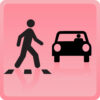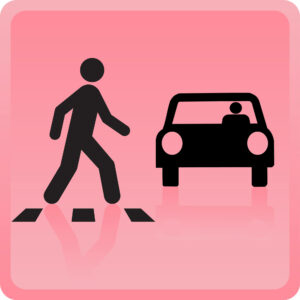
Testing Low Vision Driving Abilities Through Simulation
For those experiencing the effects of diminishing and low vision, driving can easily become one of the most difficult elements of everyday life. This can be especially trying for those dealing with central vision loss, or a blind area in their central vision.
Vision researchers in the Netherlands have recently published the results of a new study that sheds light on the connection between vision loss and driving ability. They used driving simulators and scooters to evaluate how those suffering from central vision loss are able to rapidly recognize and detect pedestrians entering their field of vision.

Those suffering from central vision loss are able to drive as long as their vision meets the restricted license requirements. However, these requirements do not take into consideration either the size or location of a blind spot.
An initial study performed years ago showed that drivers who had blind areas on the sides of their vision had a tendency to miss pedestrians. This most recent study, however, showed that drivers with blind areas above or below their center of interest (the place where they are looking) still have the likelihood of missing pedestrians. Or, they may just have a slower response time.
Essentially, anyone suffering from central vision loss in both eyes could potentially have difficulty seeing or reacting quickly to hazards entering their field of vision. However, they also show that even people with low vision can pass driving tests, despite the risks involved.
Central vision loss most commonly occurs in those suffering from age-related macular degeneration (AMD). Macular degeneration is the leading cause of vision loss in adults, especially those over the age of 50.
Age-Related Macular Degeneration
The macula is the small, detail-sensitive part of the retina. The macula allows the eye to perform tasks like reading, recognizing faces and driving. The remainder of the retina is known as the peripheral retina. It is used for peripheral vision and for identifying general shapes.
There are a few common symptoms of age-related macular degeneration. These include blurriness, dark areas or distortion in one’s central vision, or the loss of central vision altogether. Basically, the ability to see the outline of an object but the inability to make out the details.
These tests performed by researchers showed that the most delayed reactions occurred for a key reason. The drivers initially noticed pedestrians in their peripheral vision. Once the driver turned to look at them directly, the pedestrians were either partially or entirely obscured by the driver’s blind spot.
Anyone currently experiencing degrees of macular degeneration should be aware of the severity of their symptoms in order to understand their driving limitations.
However, that does not mean all is lost. While there is currently no cure for macular degeneration, there are steps that everyone, regardless of age, can take to prevent or diminish its onset or further development.
Risk Factors to Be Aware of Regarding Age-Related Macular Degeneration
Studies are inconclusive as to just what exactly causes macular degeneration. However, some risk factors include age, family history of AMD, race, gender, or the existence of AMD in the other eye.
Macular degeneration most commonly occurs in individuals over 50 years of age. It is especially common amongst those with a familial history of AMD. Caucasians and females are also at a higher risk of AMD. However, it is found among men as well as members of other races.
It is also important to know that the presence of AMD in one eye substantially raises the risk of it occurring in the other.
These elements are beyond an individual’s control. But, you can manage other lifestyle factors in order to prevent or delay the onset of age-related macular degeneration.
For example, smoking increases the risk of AMD, especially for those that are already genetically at risk. Quitting smoking is a great first step in decreasing the risk of AMD. Smoking causes damage that can contribute to the development and progression of the disease.
Poor diet and extreme obesity are other manageable factors in reducing the risk of AMD. Eating a diet high in fruit and vegetables is important for general health, as well as eye-health improvements.
Steps to Take
If you detect symptoms of age-related macular degeneration, your first step should be to seek out a proper diagnosis from an eye doctor. One symptom to look out for is blurry distance and/or reading vision. Another is the need for increasingly bright light to see up close. More to look out for include difficulty in recognizing people’s faces. A final symptom consists of a blank or blurry spot in your central vision.
Though there is no current cure for AMD. But, there are further steps you can take on your own to increase your eye health and slow the development of this disease. Quitting smoking and implementing a nutrient-rich diet can be greatly impactful. Practicing some form of physical exercise daily, such as walking or cycling, can improve your vision health.
Vitamins
The AOA says that vitamin C has the potential of decreasing the risk of AMD by as much as 25 percent. Taking zinc or vitamin A enhances this effect. Changing your diet to increase your intake of these vital nutrients has the potential to dramatically improve your eye health. It will thereby greatly decrease your risk of macular degeneration.
In addition, you can see a full list of the 17 vitamins, minerals and herbs that have been shown to support and improve overall vision and eye health.
Age-related macular degeneration is the most common cause of vision loss. So, it is vital that everyone is aware of the nature of the disease and the symptoms it involves. It’s especially important for those approaching or above 50 years of age.
As the studies above have shown, AMD can have a dramatic impact on one’s driving ability. Low vision driving cannot be as safe as healthy vision driving. So, understanding your difficulties and limitations is an important first step in ensuring everyone’s safety. Establishing and maintaining proper eye health and nutrition is a key way to immediately begin preventing or slowing the progression of age-related macular degeneration.
Our Rebuild Your Vision Ocu-Plus Formula Contains All 17 Vitamins, Minerals, and Herbal Supplements to Improve Your Eye Health!




I really enjoy the information you provide Tyler.
Actually you are a good writer and deliver the information
in an honest and forthright way.
The responses are good as well.
Does this also apply to suspicious Glaucoma?
I enjoy your commentary and links. I read that about 8 percent of seniors, 65 have Glaucoma, loss of peripheral vision. Such drivers need to keep their eyes moving for if they look straight ahead they won’t see someone or something entering from the side. Docs say glaucoma is irreversible, it can often be arrested but not cured. I hope someone proves them wrong.
about 3 years ago I had a hole in the macular I did the operation but now I have a blind spot in the middle of my eye a year ago I develop cataract in that I and did surgery to correct that but my vision is worse I can not drive at night the lines on the road Crosse each other and it is very bluer the doctors do not have a answer maybe you do thank you